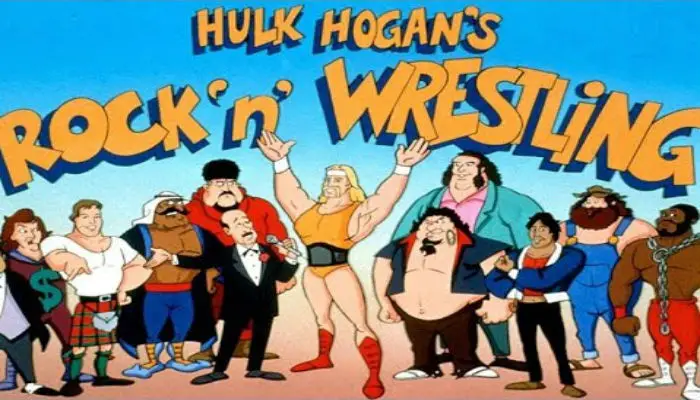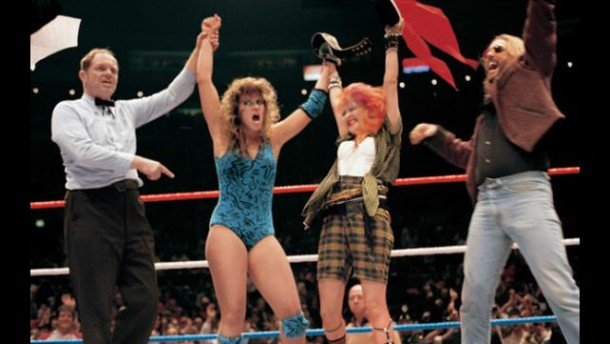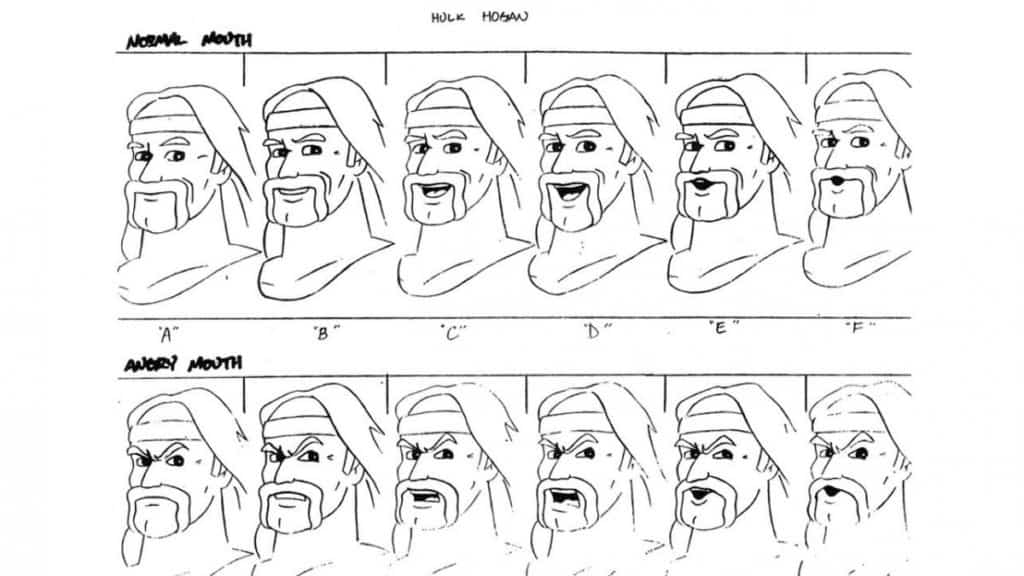
Well, Let me tell you something Brother!
During the rise and popularity of the World Wrestling Federation during the 80s they decided to capitalize on their success with a Saturday morning cartoon.
Hulk Hogan’s Rock ‘n’ Wrestling was a Saturday morning cartoon produced by DiC Animation City that featured popular WWF characters such as Hulk Hogan and Roddy Piper. It aired on CBS and ran from September 1985 to October 1986 with two seasons and 26 episodes.
Even though this was a short-lived cartoon it still is remembered fondly during the glorious era of Saturday morning cartoons. Hulk Hogan’s Rock n Wrestling was a way to capitalize on the growing popularity of – the then WWF – and even more so with Hulk Hogan and Hulkamania.
There have been some big eras in professional wrestling including the WWE attitude era and the Monday night wars between WWE and WCW. Some say that nothing can touch the popularity of pro wrestling in the mid-80s as what was once a small regional territory ‘niche interest” became mainstream and one of the hottest things going.
The WWE, and Titan Industries that controlled it, probably thought they had reached their pinnacle and had to strike while the iron was hot putting out as much content as possible – and this included hitting the Saturday morning cartoon circuit.
Here’s the story of Hulk Hogan’s Rock ‘n’ Wrestling
What Brought The WWF Into The Mainstream?
This topic can be a whole website of its own so I’m going to stick to the basics and give a quick rundown of what brought the WWF from a small regional territory and into a household name:
In the 70s, North America was basically divided up into 30 or so wrestling territories such as Mid-South Wrestling, Stampede Wrestling in Canada and the World Wide Wrestling Federation out of New York run by Vince McMahon sr.
His son, Vincent Kennedy McMahon eventually took over his father’s promotion and changed the name to the World Wrestling Federation. In those days wrestlers acted liked independent freelancers and would go from territory to territory taking on the local heroes and this allowed for them to not wear out their welcome and gain more national exposure.
One notable of this time was Andre the Giant who would be like an attraction in every territory he went. Since he didn’t remain based in one it was a big deal when he would show up in another area as it would only be for a short time, and you might not see him again for another year.
Another guy that would do this was Terry Bollea who went by various names such as Terry Boulder and Sterling Gold. He had a different look than other wrestlers with his golden blonde hair, giant physique, and tan skin and he caught the eye of Vince McMahon jr.
McMahon knew he had something special with Bollea and brought him on board while also picking up some well established characters from other territories. He knew he had a better product than the other territories and he wanted to take them all on – by going national.
He started to secure TV rights and the very early process of distributing his programming which infuriated the other territory owners, but it worked. McMahon had taken the newly named Hulk Hogan and shaped him to become a massive attraction was now getting mainstream attention.
The Rock ‘n’ Wrestling Connection

A new upstart television network called MTV had come out in the early 80s and was now becoming a pop phenomenon. It had launched new artists like Madonna and was now in the public consciousness. You need to check out the article I’ve written on the history of MTV and the birth of the first music videos to get the full story.
McMahon saw this new evolution in music as a perfect way to showcase his wrestling product and the mix of “rock” and “wrestling” appeared to be the perfect marriage of music, action, and entertainment.
Cross over work started to be done most notably involving Cyndi Lauper. Her video for “Girls Just Want To Have Fun” featured WWF manager Captain Lou Albano and Lauper would be an asset in giving the WWF more exposure to a whole new audience.
This would also lead to some other cross promotional events, most notably “The Brawl To End It All” which took place on July 23, 1984. This was a WWF event that was broadcast live on MTV and the theme of the event was taken from the fictional story line of the “Girls Just Want To Have Fun” music video. In the video Captain Lou is an overly protective figure, and the story continues into “real life” where his sexism annoyed lauper to no end.
The focus of the event would have WWE women’s wrestler Wendi Richter represent Lauper who would take on the Fabulous Moolah who was managed by Captain Lou. This event would also feature other WWF wrestlers exposing them to an audience that had never seen them before. But only the final match was broadcast on MTV.
And it worked. “The Brawl To End It All” was a massive hit and scored a 9.0 rating making it the most watched show in MTV history.
Keeping This Momentum Going
Vince McMahon is like the modern day P. T. Barnum of Barnum and Bailey’s circus and he is a master promoter and marketer. Thanks to the success of the Brawl to end it All another event was developed called “The War To Settle The Score”.
This whole WWF/MTV connection was now officially called the “Rock n Wrestling Connection” and The War To Settle The Score would carry the momentum of the first event. This time Captain Lou and Lauper had “reconciled” and during an event they were both attacked by Rowdy Roddy Piper who would be thwarted by the newly growing stalwart of the WWF – Hulk Hogan.
This would lead to Hogan facing Piper for the WWF championship at the live event that took place at Madison Square Garden on February 18, 1985. The card featured many other matches but Hogan vs Piper would be the one that aired live on MTV, and the whole country got their first real look at Hulk Hogan.
Hogan would win by disqualification as the match was interfered with by Cowboy Bob Orton and Paul “Mr Wonderful” Orndorff (if you’re a WWE fan you know where this is going). Sitting at ringside – and who would help Hogan at the end of the match – was TV celebrity Mr. T.
This would help set up, and lead to, the biggest event in pro wrestling history
WrestleMania 1
Built on the back of “The War To Settle The Score”, WrestleMania 1 was the most ambitious event in pro wrestling history. It would combine wrestling, music, and celebrities in a giant culmination held in Madison Square Garden on March 31, 1985. The focus of the event would involve Mr. T and Hulk Hogan taking on Orton and Orndorff.
This was the biggest gamble of Vince McMahon’s career and he threw everything he had into it including an apparent second mortgage on his home that his wife was not aware of. It would also take advantage of a new technology called “closed circuit television” which means that people could watch the event live in a theatre in their own city. It’s funny to look back on but this was revolutionary at the time and I would have given my life to go. Not only was I a bit too young but closed circuit was also expensive AF.
WrestleMania 1 featured celebrities such as Muhammad Ali, Liberace and, of course, Cyndi Lauper. This was basically throwing all your eggs into one basket and it worked, big time. The event was seen as a huge success and around a million people watched in on closed circuit around the country.
This event also propelled Hulk Hogan to even loftier heights. So how were they going to capitalize on the increase in popularity that he, and the WWF, had now found themselves in?
Heading To Saturday Mornings

Not surprisingly, with an industry built on larger than life “superheroes”, the main audience for Hulk Hogan and the WWF were kids like me. This is when wrestling was still “real” to all of us and we treated it almost like sport. This is years before the steroid scandal would hit but Hulk Hogan appeared on the cover of Sports Illustrated and newspapers would print results of wrestling shows like it was an actual sporting event.
Hulkamania was running wild (the name was given by WWF announcer Howard Finkel noting it was like “Beatlemania”) and children were encouraged to “say your prayers and take your vitamins” – two things I continue to do to this day.
The WWF decided to keep this kids friendly approach by putting together a cartoon show that would air on Saturday mornings – aka the holy grail of kids programming. It would be called Hulk Hogan’s Rock ‘n’ Wrestling which would connect to the “Rock ‘n’ Wrestling Connection” that had boosted their popularity in conjunction with MTV.
The show would be produced by DiC Animation City which brought us Inspector Gadget among other shows. The premise of the show would take the very basic approach that wrestling had of good guys vs bad guys and would feature Hulk Hogan leading the good guys against a group of rogue wrestlers led by Rowdy Roddy Piper.
This allowed the show to follow the basic cartoon tropes of good vs bad and both groups put into
wacky situations that result in the good guys coming out on top.
The Basic Break Down Of Hulk Hogan’s Rock ‘n’ Wrestling
Besides cartoons, the show would feature live-action segments and they also kept trying to plug their WWF album – which was a real thing – with video clips of their showcase song “Land of 1000 Dances” which I kind of loved at the time. There’s also the iconic “Piledriver” which seems like WWF’s attempt to get on board with music videos that were driving the success of MTV.
Since WWF wrestlers spend around 300 days of the year on the road, they weren’t available to provide the voices for their characters and professional voice actors were brought in.
But here was the one major problem facing Hulk Hogan’s Rock n Wrestling, and this requires a quick wrestling 101…
In pro wrestling the good guys are known as “baby faces” and the bad guys are known as “heels”. From time to time, a good guy could turn heel while a bad guy could turn “face” and this is how they would keep storylines going. The plan with Hulk Hogan’s Rock n Wrestling was that the cartoon would try to follow the storylines that were happening in the real life WWF.
The problem was the production time for each episode took so long that they had no way of staying up to date which was causing some crossover issues. The biggest example of this is how Rowdy Roddy Piper was the main bad guy when the show debuted but in the WWF ended up turning “face”.
Same thing for Andre the Giant who was one of the main good guys in the cartoon, and in real life when it started, but would end up turning heel not long after. But whatever, we were pretty dumb kids and probably didn’t really notice.
The Release Of Hulk Hogan’s Rock ‘n’ Wrestling
The show debuted on September 14, 1985 just about six months after WrestleMania which is a pretty quick turnaround at the time, but was still right in the mix of all things Hulkamania. It would run until October 18, 1986 and would be made up of two seasons and 26 episodes.
Some notable voice actors that were featured in the show included comedian Brad Garrett (from Everyone Loves Raymond) who voiced Hulk Hogan, Ron Gans (the voice of Eeyore on Winnie the Pooh) who voiced Nikolai Volkoff, and James Avery who is of course Uncle Phil from The Fresh Prince of Bel Air who voiced the Junkyard Dog.
Here were the main characters featured on the show:
Good Guys:
- Hulk Hogan
- Junkyard Dog
- Captain Lou Albano
- Jimmy “Superfly” Snuka
- Andre the Giant
- Wendi Richter
- Hillbilly Jim
- Tito Santana
Bad Guys:
- Rowdy Roddy Piper
- The Iron Sheik
- Nikolai Volkoff
- Bobby “The Brain” Heenan
- The Fabulous Moolah
- Big John Studd
- Mr. Fuji
How Did This Show Go Over?
It was safe to say that this was a fairly big hit as the WWF was starting to hit its stride and Hulkamania was absolutely massive. It’s also notable that success was hard to come by in the cartoon world as we’re entering into the golden age of kids cartoons in 1985/86 so to last for two seasons and 26 episodes was nothing to sneeze at.
The Mr. T cartoon show put out the year before seemed to be a good way to test the waters and his cereal of course was a huge hit. Check out my article all about the best cereals from the 1980s – spoiler alert: Mr. T cereal makes the list…
Some critics were not on board with Hulk Hogan’s Rock ‘n’ Wrestling but wrestling, in general, was still looked at sort of dismissively as it was. An article from the Orlando Sentinel from April 24, 1985 talks about the upcoming Saturday morning cartoon releases coming from CBS and basically craps all over it.
It was thought that basing a show on Hulk Hogan was ridiculous as “surely they could have found somebody a little more heroic around whom to construct a cartoon series.” They clearly didn’t see the massive impact that Hulk Hogan, Hulkamania, and the WWF would have on an entire generation of kids.
It also wasn’t a failure as mentioned as it lasted two seasons amidst a ton of competition. Also coming out at the same time as Hulk Hogan’s Rock ‘n’ Wrestling were some pretty notable cartoons such as:
- The Wuzzles
- The Gummi Bears
- The Berenstain Bears (NOT BerenstEin Bears)
- The Punky Brewster cartoon
- The Ewoks & Droids Adventure hour
The Music For Hulk Hogan’s Rock ‘n’ Wrestling
If you’re familiar with Hulk Hogan, you know that “Real American” is his iconic theme song but before that was written for him by Rick Derringer he would come to the ring to “Eye of the Tiger” and then, for a short while, the theme from Hulk Hogan’s Rock ‘n’ Wrestling. The theme they came up with was called “Hulk Hogan’s Theme” and was written by Jim Steinman.
Steinman has produced music like Bat Out of Hell, Total Eclipse of the Heart and for artists such as Barry Manilow, and Celine Dion – so who better to make music for Hulk Hogan!
Hulk Hogan’s Theme definitely had a bit of a Rocky vibe to it but it did its job. Steinman would later rework this theme into a song for Bonnie Tyler called “Ravishing” that was in no way related to Rick Rude…
Wrapping It Up
Hulk Hogan’s Rock ‘n’ Wrestling probably wasn’t amazingly good, but it didn’t matter because a lot of the cartoons we grew up on are not that amazing when you look back at them. In this case, it didn’t totally matter how epic it was because it was all about getting the content out there in the height of the Hulkamania popularity.
It was good enough at the time to get our attention and for me personally, I wanted to watch anything that had to do with WWF and Hulk Hogan. So Hulk Hogan’s Rock ‘n’ Wrestling exists as a semi-successful short-lived cartoon that actually had the premise to be really good. Again, with things that are popular, it’s just about getting something out there and hoping it sticks.
It exists somewhere in that Prostars range of cartoons where production companies were throwing anything at the wall during this onslaught of products and cartoons that were now flooding the market. I feel like there was barely time to do market research as there was a short window to try to ride this wave of possible merchandising that was flooding the market.
Unlike shows like G.I. Joe, or Transformers, that were created only with the intention of selling toys, Hulk Hogan’s Rock ‘n’ Wrestling was a little different in that it seemed to exist just as an offshoot of the live WWF product. They, of course, had toys and merchandising but the cartoon seemed to exist as its own entity and to also, of course, bring attention to the live product.
This made it a little more unique but regardless of its ultimate intent, it worked for me.
O.K, take it away WWF! (is that Meatloaf on drums??)




Comments
Comments are closed.